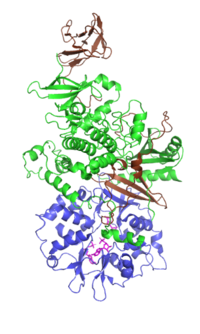
Photo from wikipedia
BACKGROUND Statins mostly target the liver; therefore, increase in the synthesis of cholesterol by extra-hepatic tissues and then transferring this cholesterol to the liver can be regarded as adaptive responses… Click to show full abstract
BACKGROUND Statins mostly target the liver; therefore, increase in the synthesis of cholesterol by extra-hepatic tissues and then transferring this cholesterol to the liver can be regarded as adaptive responses by these tissues. In addition to cholesterol, these adaptive responses can increase isoprenoid units as the byproducts of the cholesterol biosynthesis pathway; isoprenoids play a key role in regulating cell signaling pathways and cancer development. Thus, there is a primary need for in vivo investigation of the effects of statins on the cholesterol metabolism in the extra-hepatic tissues. MATERIALS Eighteen male Sprague-Dawley rats were randomly divided into control (n = 9) and treatment (n = 9) groups. The treatment group was orally given 10 mg/kg/day of Rosuvastatin for 6 weeks. Then, serum lipid profile, expression levels of 3-hydroxy-3-methyl-glutaryl-coenzyme A reductase (HMGCR), ABCA1, ABCG1 and ApoA1, and activity of HMGCR were measured in the liver, intestine and adipose tissues. RESULTS Rosuvastatin significantly reduced total cholesterol and LDL-C. The expression levels of ABCA1, ABCG1, and ApoA1 in the liver and HMGCR in both liver and intestine were significantly increased in the Rosuvastatin treated-group. However, in the intestine, there were no significant differences in the expression levels of ABCA1 and ABCG1 between the study groups. Rosuvastatin had no effect on the adipose tissue. The HMGCR activity was significantly increased in the liver and intestine of the Rosuvastatin-treated group. CONCLUSIONS In spite of the adipose tissue, the intestine efficiently responses to the reduced levels of cholesterol and increases its cholesterogenesis capacity. However, adipose tissue seems to play a small role in correcting cholesterol deficiency during the course of statin therapy.
Journal Title: Gene
Year Published: 2018
Link to full text (if available)
Share on Social Media: Sign Up to like & get
recommendations!